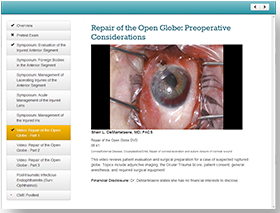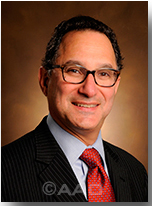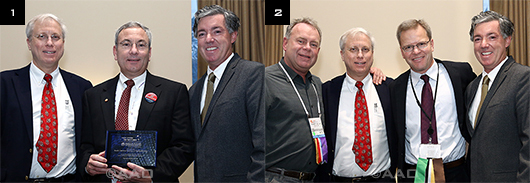What's Happening
ICD-10 Is Looming: The Academy Helps You Prepare
On Oct. 1, ICD-10 will go into effect in the United States. To ensure a smooth transition, the American Academy of Ophthalmic Executives (AAOE) designed the 2014 CODEquest courses to focus on preparation for ICD-10. These state-specific seminars break down the new rules, demonstrate ICD-10’s use via real-life case studies, decipher technical terminology, and clarify the respective responsibilities of physicians, administrators, technicians, coders, and billers. These courses are run in conjunction with state societies.
For more information, visit www.aao.org/codequest.
Workshop: Developing Novel Endpoints for Premium IOLs
On March 28, the Academy and the Food and Drug Administration (FDA) are cosponsoring a meeting for all interested clinicians, researchers, and industry and regulatory officials to improve the regulatory science for evaluating premium IOLs. This sets a precedent for FDA collaboration with a medical specialty society to enhance innovation in the United States in an evolving area of medical devices. Results expected from this workshop include the development of consensus clinical statements and white papers, as well as proposals for preclinical and clinical research studies to enhance the efficiency of bringing safe and effective premium IOLs to the market.
Malvina B. Eydelman, MD, Director of the Division of Ophthalmic, Neurological and Ear, Nose and Throat Devices, at the FDA said, “This innovative approach to ophthalmic endpoint development is a game changer. Not only will it allow experts to address the challenges facing endpoint development for premium IOLs, but it will also incorporate input from all interested parties to produce prioritized approaches to measure them.”
Take Notice
FAAO Annual Report
Thanks to generous donations to the Foundation of the Academy in 2013, the following programs were made possible:
- A redesign of the Ophthalmic News and Education (ONE) Network, featuring improved site usability and support for mobile devices.
- Development of the Hoskins Center’s IRIS Registry,the nation’s first comprehensive eye disease patient database.
- The Michael R. Redmond, MD, Professionalism and Ethics Education Center, the Bruce E. Spivey, MD, Fund for Risk Management Studies, and the Michael F. Marmor, MD, Lecture in Ophthalmology and the Arts.
Read more in the Foundation annual report, titled Shared Vision, Global Impact, at www.faao.org.
 ONE SPOTLIGHT: Address practice gaps with Learning Plans. Build a thorough understanding of current clinical topics with multistep, multimedia Learning Plans—a new feature of the revamped ONE Network. Learning Plans are collections of ONE Network content hand-picked by its editors. Each plan addresses a commonly misunderstood topic and contains courses, cases, videos, and journal articles to improve clinical knowledge and build new skills. Titles of current Learning Plans include Management of Corneal Lacerations and Anterior Segment Trauma, Treatment of Noninfectious Ocular Inflammatory Disease, and Ocular Surface Neoplasia. ONE SPOTLIGHT: Address practice gaps with Learning Plans. Build a thorough understanding of current clinical topics with multistep, multimedia Learning Plans—a new feature of the revamped ONE Network. Learning Plans are collections of ONE Network content hand-picked by its editors. Each plan addresses a commonly misunderstood topic and contains courses, cases, videos, and journal articles to improve clinical knowledge and build new skills. Titles of current Learning Plans include Management of Corneal Lacerations and Anterior Segment Trauma, Treatment of Noninfectious Ocular Inflammatory Disease, and Ocular Surface Neoplasia.
To view, visit www.aao.org/learningplans. |
For the Record
Election Results
On Nov. 18, voting opened for six positions on the 2014 board of trustees. The results are as follows:
- President-elect: Russell N. Van Gelder, MD, PhD
- Senior Secretary for Ophthalmic Practice: Robert E. Wiggins Jr., MD, MHA
- Secretary for Annual Meeting: Jonathan B. Rubenstein, MD
- Trustee-at-large: Jane C. Edmond, MD
- Chair, the Council: Ann A. Warn, MD, MBA
- Vice Chair, the Council: Mathew W. MacCumber, MD, PhD
They began their terms on Jan. 1.
For more information on the board of trustees, which is the policy-making body of the Academy, visit www.aao.org/bot, where you can see biographies of all the current members.
Nominations for the Academy Board
 |
| Dr. Sternberg. |
By Paul Sternberg Jr., MD
As past president of the Academy, it is my privilege to serve as chairman of the Academy’s Nominating Committee in 2014. This committee represents a variety of interests within the Academy and is charged with identifying appropriate candidates for the open positions on the 2015 board of trustees.
We are especially interested in identifying leaders in our profession with experience in confronting the critical issues facing organized medicine and who reflect the strength and diversity of our members. The Academy’s leaders should be knowledgeable, experienced, and prepared to devote the time and energy required by a large organization in these challenging times. This work is both demanding and rewarding for those interested in helping to assure the Academy’s success and responsiveness to members. With these characteristics in mind, I ask you to assist the committee by suggesting appropriate candidates for the following positions in 2015.
- President-elect (to serve as president in 2016). Because the president-elect automatically becomes president the following year, it is crucial that nominees are individuals who have had leadership experience within the Academy. They also should have demonstrated leadership qualities in clinical practice, in their own ophthalmic communities, and in other medical or ophthalmological organizations.
- Senior Secretary for Advocacy (three-year term). This senior secretary coordinates the Academy programs and activities that are developed through the Secretariat for Federal Affairs and the Secretariat for State Affairs.
- Trustee-at-large (four-year term). This individual should be an Academy fellow who is especially attuned to the needs and expectations of our members. In addition to demonstrating strong leadership potential, he or she should be able to represent and articulate the needs and concerns of members to the Academy board.
- One public trustee (a renewable three-year appointment; an advisor to and member of the board of trustees). The bylaws allow the board to appoint up to three public trustees. We currently are served by Humphrey J.F. Taylor and Paul B. Ginsburg, PhD. Mr. Taylor is chairman of Harris Interactive and will complete his seventh term in 2014 and is eligible to be nominated for an eighth term. Dr. Ginsburg is president of the Center for Studying Health System Change and is serving the first year of his fourth term. Public trustees do not vote on Academy governance, the budget, or other programmatic issues. They do, however, provide insight on how ophthalmology can better work with the rest of medicine, the public, government, and industry. A public trustee should not be an ophthalmologist but should be someone who is familiar with and has a personal interest in current medical issues. The nominating committee will be pleased to receive suggestions for individuals, who may include physicians from other medical specialties or leaders in industry, government, public policy, or advocacy.
- One international trustee-at-large (three-year term). This individual should be an Academy international fellow or member who practices exclusively outside the United States. He or she should have a strong affinity for the Academy, broad experience, and a deep understanding of his or her region. In addition to demonstrating strong leadership potential, he or she should be able to represent and articulate the perspective of international members to the Academy board. International trustees do not vote on Academy governance, the budget, or other programmatic issues.
Submit nominations. Thank you for your interest and participation in this process. Membership participation is vital, not only for the Academy but also for our collective goals of being able to provide appropriate, accessible, and affordable eye care to the public. On behalf of the Nominating Committee, I look forward to receiving your suggestions as we seek to identify our profession’s future leaders.
Send your confidential suggestions by Jan. 31 to Paul Sternberg Jr., MD, Nominating Committee Chair, American Academy of Ophthalmology, P.O. Box 7424, San Francisco, CA 941207424. Suggestions can also be e-mailed to nominate@aao.org or faxed to 415-561-8526.
For more information, visit www.aao.org/elections and click “2014 Election Nominations.”
D.C. Report
Engagement Encouraged in Open Record Program
Last August, manufacturers of drugs, biologics, and medical devices/supplies began reporting transfers of value to physicians. They report this information to the U.S. Department of Health and Human Services. The reporting, mandated by the Physician Payments Sunshine Act, a component of the Affordable Care Act, is intended to delineate the financial relationships and ownership interests between industry and physicians.
The Sunshine Act: a breakdown. The Sunshine Act does not restrict industry-physician interactions or prohibit payments or transfers of value—it simply requires them to be tracked and reported. In addition to reporting on payments, industry must report ownership and investment interests held by physicians and their immediate family members. This is to encourage transparency and limit inappropriate influence and conflicts of interest. Information about payments and transfers of value must be reported when an item is worth $10 or more, or if the sum of all items over a year exceeds $100. Typical transfers of value include gifts, consulting fees, research activities, speaking fees, meals, and travel. Educational materials and product samples that directly benefit patients or are intended for patient use are excluded from reporting requirements. Manufacturers must, by the end of March 2014, report all transfers that occurred between August and December of 2013. The compiled information will be used to create reports on individual physicians, which CMS will make available to the public by Sept. 30, 2014.
The physician’s role. While physicians do not have reporting responsibilities, they should have an understanding of the program and take time to review their reports for accuracy. Beginning in August—prior to public release—physicians will be able to review their reports on the CMS Open Payments website, as well as dispute any errors or discrepancies. Physicians are also encouraged to regularly review and update all of their financial and other conflict of interest disclosures that are on the Academy website.
To review your reports in August, visit www.cms.gov and select “Regulations and Guidance,” then “Open Payments” under Legislation.
For details about the Sunshine Act, including what must be reported, who must report, and key dates, visit bit.ly/financialtransparency.
Academy Store
2014 Focal Points: 100+ Clinical Pearls
Focal Points is the Academy’s publication that addresses clinical challenges. Focal Points Digital subscribers can view a new online issue every month, and they may now access the entire Focal Points archive of more than 100 topics. Focal Points Digital has an updated design and is optimized for your mobile tablet; additionally, all issues are downloadable, printable, and searchable. The print edition has been redesigned as well, for easier reading. Print subscribers get all the benefits of Focal Points Digital, plus 12 print issues a year.
For more information and to subscribe, visit www.aao.org/focalpoints.
New! Online Course: ICD-10 in 90 Minutes
This 90-minute interactive course (#0120355V) shows you how to select new ICD-10 codes correctly every time. Topics include new coding rules, new terminology, usage guidelines, case studies, and a step-by-step implementation guide. The 2014 ICD-10-CM for Ophthalmology (#0120343) book is recommended as an accompaniment, as it is referenced throughout the online course.
For more information and to order, visit www.aao.org/store.
New! Retina Informed Consent Video Collection
Make your informed consent process more consistent and thorough with the Academy’s downloadable Retina Informed Consent Video Collection (#057162V). This collection includes 21 short videos, each about five minutes long, on common retinal conditions, the risks and benefits of procedures, and treatment options. These videos enhance patient understanding of procedures and potential complications, encourage consent, improve compliance, and set realistic expectations to mitigate malpractice risk.
With versions in both English and Spanish, the videos feature an ophthalmologist (played by an actor), animations, and explanations. All videos are available in a variety of file formats for desktops, laptops, smartphones, and tablets.
To view clips and order, visit www.aao.org/retinavideos.
Meeting Matters
2013 Meetings on Demand
See the symposia and courses that you weren’t able to attend during the 2013 Annual Meeting with AAO Meetings on Demand. More than 200 hours of content are available for viewing at your convenience.
Order the Subspecialty Day meetings or the Annual Meeting highlights separately, or get the Premier Collection, which contains both. Your order will include online access and a USB drive for offline access on select products. Although the files contain slides and synchronized audio, you can also download just the MP3 files.
To order, visit www.aao.org/ondemand.
Meeting Archives
Visit the Meeting Archives to download course handout PDFs, find scientific posters, view syllabi from the Subspecialty Day meetings, and more.
For more information, visit www.aao.org/aao-archives.
2014 Abstract Submission Deadlines
If you are interested in being a presenter at the 2014 Annual Meeting, you must submit abstracts online.
For instruction courses and new Skills Transfer courses, the online submitter closes on Jan. 14.
For papers, posters, and videos, the online submitter opens on March 12 and closes on April 8.
For more information on submitting an abstract, go to www.aao.org/annual-meeting and select "Presenter Central."
AAO 2014 in Chicago
AAO 2014, in conjunction with the European Society of Ophthalmology, will take place Oct. 18-21 at the McCormick Place Convention Center in Chicago, preceded by the Subspecialty Day meetings on Oct. 17 and 18.
For more information, visit www.aao.org/2014.
Members at Large
In mid-January, view the International Ophthalmologist Education Award and International Scholar Award recipients at www.aao.org/international/awards.
OMIC’s New Leadership
On Jan. 1, Tamara R. Fountain, MD, succeeded John W. Shore, MD, as Chairperson of OMIC’s Board of Directors. Dr. Fountain pointed to Dr. Shore’s nearly 30 years of leadership: “We are navigating the changes in health care better than many other specialties because of the years of service of dedicated ophthalmologists like Dr. Shore, who has led our company during many of our most successful years. I pledge every effort to continue to meet such high standards during my service as OMIC’s Chairperson.”
 |
|
STATE AFFAIRS AWARD. (1) South Carolina. From left to right: Steven C. Thornquist, MD (Academy Associate Secretary for State Affairs), Kurt F. Heitman, MD (Academy Councilor for the South Carolina Society of Ophthalmology), and Daniel J. Briceland, MD (Academy Secretary for State Affairs). (2) Oregon. From left to right: Robert E. Tibolt, MD (member and past President of the Oregon Academy of Ophthalmology), Dr. Thornquist, Steven L. Mansberger, MD, MPH (President of the Oregon Academy of Ophthalmology), and Dr. Briceland.
|
State Societies Honored During Annual Meeting
On Nov. 18 during the Annual Meeting, the Academy’s Secretariat for State Affairs honored two societies with its State Affairs Star Award.
The State Affairs Star Award program provides special recognition to state ophthalmology societies for outstanding efforts on programs or projects they have implemented in the previous year. The winning programs are as follows.
- Oregon Academy of Ophthalmology for its Join Your State Representative for a Free Glaucoma Screening project, established to provide a valuable public service program while building relationships with key state legislators.
- South Carolina Society of Ophthalmology for its Operation Patient First program, which organizes local fund-raising events for state legislators and their leadership councils.
To date, the Secretariat for State Affairs has recognized 54 state ophthalmology society programs with the State Affairs Star Award. State ophthalmology societies may apply for this award by responding to the Secretariat for State Affairs’ annual organizational survey of state societies.